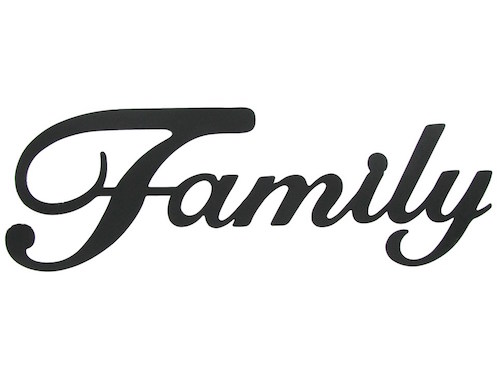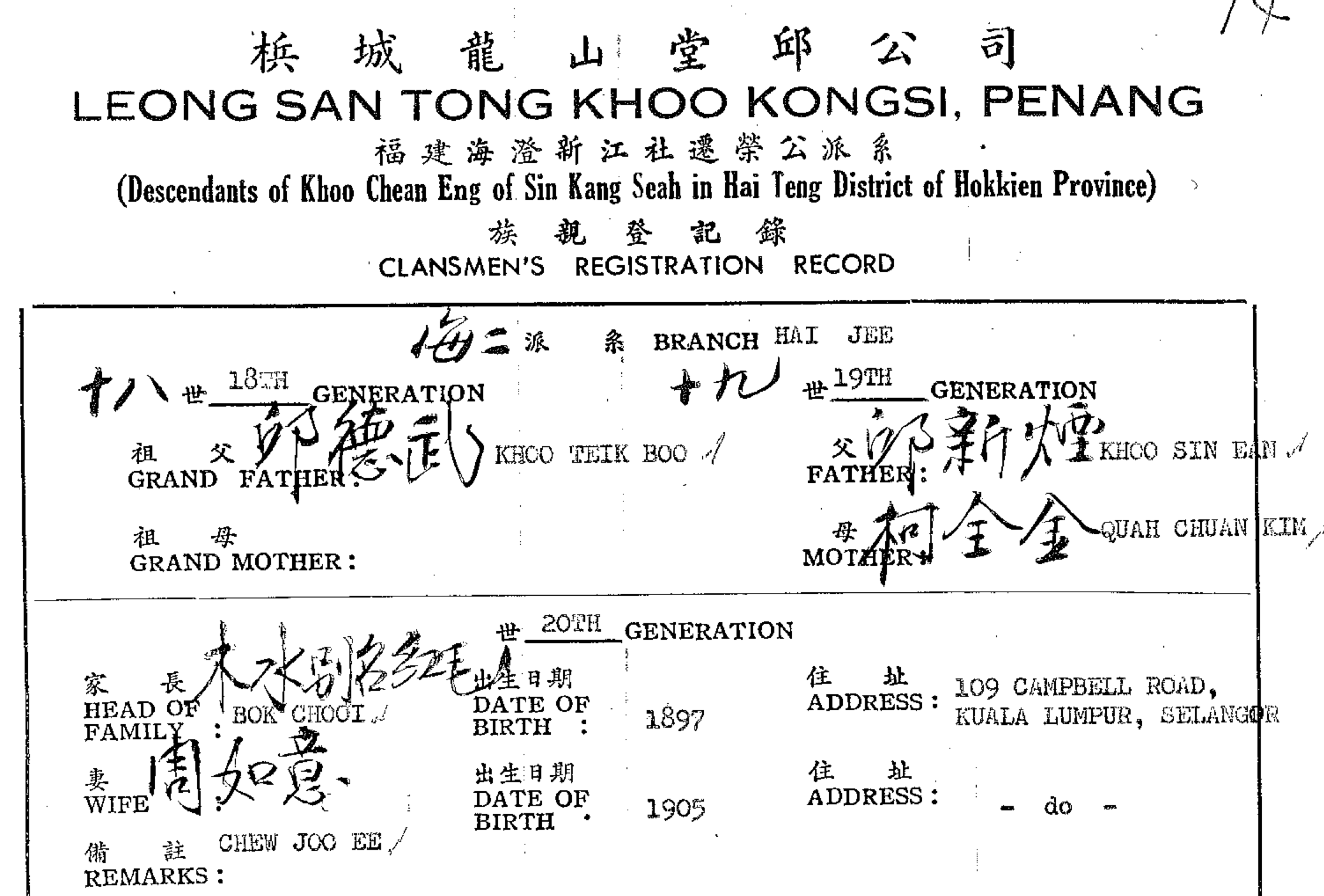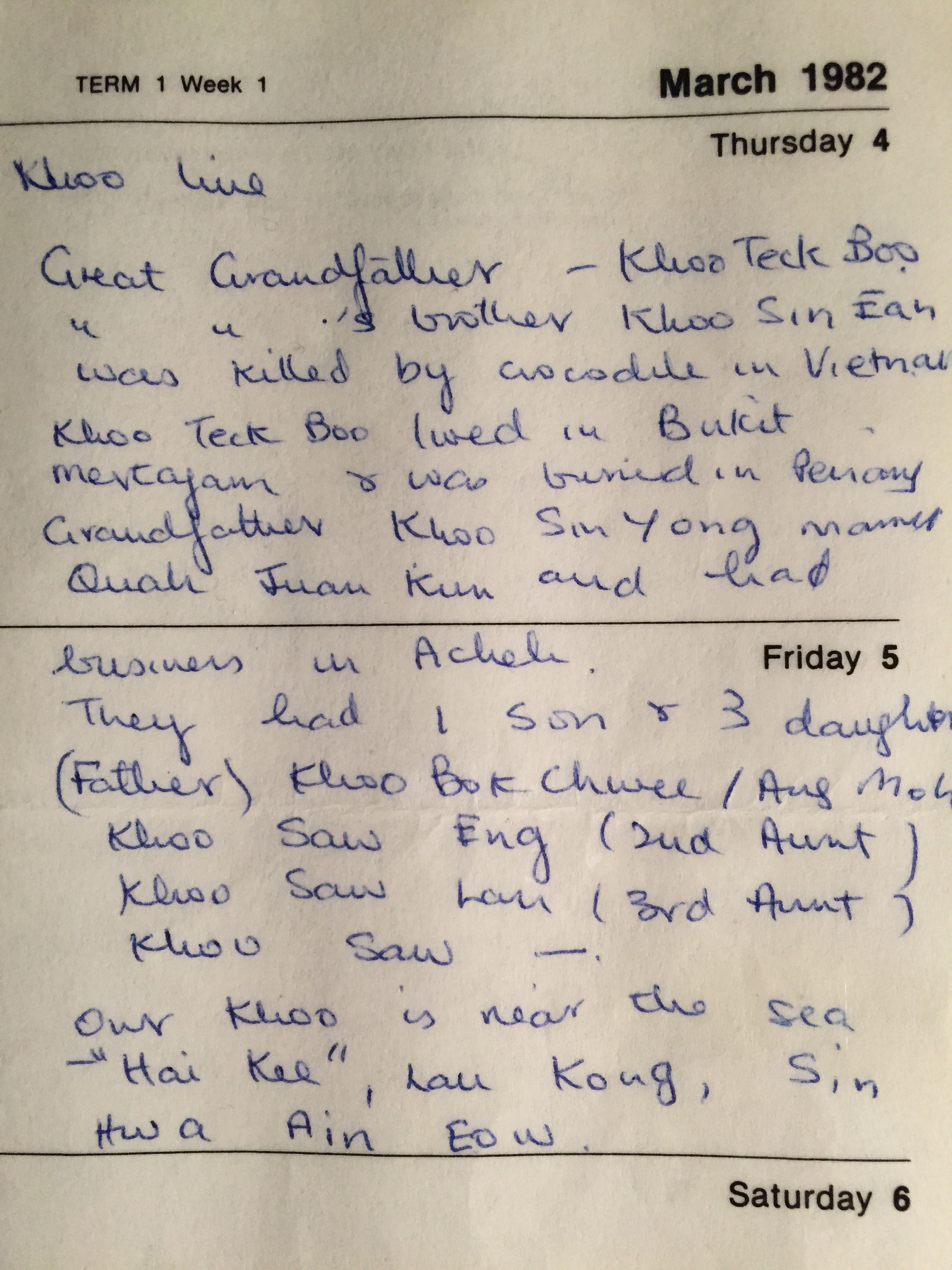In order to continue the same style and approach to writing these family stories for my mother’s side of the family I would first need to know a lot more about the earliest Khoo & Lim ancestors.
Khoo Kongsi Clansmen’s Record
The earliest ancestor from the Khoo side of the family that I have a name for is my grandfather’s grandfather. Written in my mother’s diary some time in the 1980s, she wrote his name down as Khoo Teik Boo. This has since been confirmed by the Clansmen’s Registration Record which I obtained a copy of one year ago when visiting the Khoo Kongsi in Penang, Malaysia.
This document shows how my local Khoo family fits into the wider descendants of Khoo Chean Eng. Key information on my great-great-grandfather from this document indicate that he was a member of the 18th generation. The other pertinent piece of information is the branch – Hai Jee. In the original diary record of my mother, she had written down some other notes that reflecting a different understanding – that our branch was the Hai Kee. Based on the clan structure of the Khoo Kongsi, the Hai Jee is one of 13 branches and is one of five Hai Kee Kak. In this way, my mother’s information can be harmonised with the official record. The lineage at the top starting with Khoo Chean Eng is:
- Khoo Chean Eng
- Khoo Buan Seng
- Khoo Guan Heng
- Khoo Kong Oon
- Khoo Keong Sin
Khoo Teik Boo as a member of the 18th generation, should have had a name starting with Khoo Thai instead, according to the generational poem. His son Khoo Sin Ean should have also started Khoo Heng, with my grandfather belonging to the Soo/20th generation. What is interesting is that the 21st generation – or my mother’s generation – sees a return to the generational poem tradition and all my uncles were thus named Khoo Kay…
Mother’s Genealogical Research
Khoo Teik Boo lived in Bukit Mertajam, on the mainland opposite Penang Island. He had two sons – Sin Yong and Sin Ean. According to the notes recorded by my mother (image above), Khoo Sin Ean “was killed by a crocodile in Vietnam”. Teik Boo was buried in Penang – the significance of this statement and context given that he lived outside Penang in Bukit Mertajam suggests that he may have been buried in the Hokkien Chinese Cemetry…
Khoo Sin Yong married Quah Juan Kim and had business in Aceh. The couple’s lives ended abruptly and for unspecified reasons, other than their three children were orphaned and came to the Khoo Kongsi in Penang for assistance. Khoo Bok Chwee was the eldest and only son – my grandfather – and he not only had to fend for himself, but also care for his two younger sisters Saw Eng and Saw Lau. According to the handwritten notes a third youngest daughter had been born but both her name and fate are unknown. Khoo Saw Eng, my grand-aunt would go on to marry Lim Boon Seong. In this way, the following is half of the final chapter written by my uncle/mother’s cousin in his Genealogy of the Lims, which I have reproduced in the final section below. Quah Juan Kim gets a mention in the write-up below as having two half-sisters who were based in Tapah. One married a Tan whilst the other married an Ong.
Researching more into what Aceh was like around the 1900s, this was the time of the Dutch War (1873 – 1914). The Aceh Sultanate fell in 1903 with the last (35th) Sultan Aladdin Muhammad Da’ud Syah surrendering to the Dutch forces who had slowly been influencing the local potentates to give a pledge of allegiance to the Dutch colonial powers. Whether or not the resistance movement claimed the lives of Khoo Sin Yong and Quah Juan Kim is unknown. It is known, based on the details below, that the half-sisters of Quah Juan Kim were safe from the conflict back in Perak.
Update: according to one of my second cousins who grew up with his grandmother & aunt, great-grandfather Khoo Sin Yong died in Singapore. This is also a possibility since, as a businessman, he would travel between the major towns. One theory is that his business interests got tangled up in some of the resistance movement and great-grandfather Sin Yong got injured. Perhaps Singapore was the nearest medical facility but it was not enough to save him… This is just a speculative thought so in the absence of something more concrete I will promote this as a possible explanation to the fate of Khoo Sin Yong.
Lost Family History…
Over the years, my uncles and aunts have shared details with me on the generations before. Whilst a lot of focus shifts in these conversations to their mother (my grandmother’s Chew family), one recurring story that resurfaces is that my grandparents were already related to one another such that they were cousins of sorts. No details are available, but the thought here is that instead of having eight different grandparents, both Khoo Bok Chwee and Chew Joo Ee (my grandparents) had six or seven grandparents between them.
To bring this back into the context and focus of this article, that would suggest that Khoo Sin Yong or Quah Juan Kim are half-siblings or cousins of either Chew Sim Ann or Goh Eng Neoh… The common thread here is that Chew Sim Ann (and possibly Goh Eng Neoh) were from Aceh/Medan (not sure which). Stories focusing on the Chew family will form future articles, but it is more likely that the two wives are part of the family connection here…..
A Union of Khoo & Lim
Written from the perspective of my uncle/mother’s cousin, son of Khoo Saw Eng
Mother (Khoo Saw Eng) was born in the year of the Rabbit (1903) in Penang. I recall being told she spent her younger days in the Kampong of Relau in Penang. At the turn of the century, Penang must have been a very matriarchal family. My own experience living with some of our relatives in Penang shortly after World War II tends to confirm this view. Then, three families lived in No. 8, Kinta Lane. They were the families of two sisters and the married (with family) daughter of a third sister. So the males were referred to as so and so’s husband or brother-in-law or something. The reference point was always the female member. The reason for this, I surmise, was that as a port Penang served as collection and dispersion point for the immigrants from China. Many of them then dispersed from there to Peninsular Malaya, Sumatra and Burma. In modern parlance, there then existed many single-parent families and children knew their mothers much better than their fathers. Another feature of this matriarchal trend is the higher incidence of the custom of “Jin Juay” which refers to the marriage custom where the male would stay with the wife’s family after marriage and where there would be an agreement about what surname the (male) children would assume. Usually they would have either double surnames or a certain number of the male offspring would take the mother’s surname. I have schoolmates in Penang whose brother(s) had different surname whilst others have double-barreled surname. In the Malaysian states, this practice seems to be observed only in Penang.
Mother came to Tapah during the World War I years (1914-1918) to stay with her then rich aunt who was the half-sister of her mother whom we accordingly addressed as Ang Ee Po (“Po” signifies that she was of grandmother’s generation). Also staying with Ang Ee Po was another half-sister of grandmother whom we called Lak Ee Po. The latter and mother, having grown up together remained close throughout. So, apart from the families of Mother’s older brother (vide infra) and her younger sister’s, Lak Ee Po’s family is the one we know best on the distaff side.
A footnote: Lak Ee Po married Mr Ong Chan Seng of the family who built No. 46, Station Road, Tapah. Both the Ong family and the family of Ang Ee Po (Mrs Tan) were well-to-do people in Tapah in those days but evidence suggests that they were casualties of the post WWI recession. And as the fortunes of the Ongs and the Tans declined, the Lims who bought over the aforementioned house and have lived there ever since came to be among the leading families in Tapah. I believe the patriarch of this family, Mr Lim Siok Tan made his first fortune supplying food to the people who build the road to Cameron Highlands.
Uncle Khoo Ang Moh/Bok Chwee, mother’s older brother was born in Penang and had a Standard 4 education, which put him among the better educated by the standards of those days. Indeed, our father either because he was such an admirer of Uncle or, not quite convinced of the merits of education, often cited this to prove his point that one does not need more than a few years in school to be able to earn a good living.
Auntie Be Ee, mother’s younger sister and much the more articulate of the two, told me of some members of her (Khoo) family who had migrated to Burma. Medan, in North Sumatra, is even today a twin of Penang. Indeed, Uncle Khoo Ang Moh, mother’s older brother, got married there (1922) and the two eldest among our cousins in KL spent their early childhood there.




1 comment
Comments are closed.